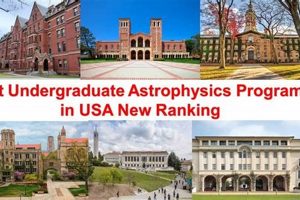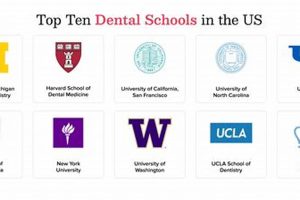Top-tier institutions for art education in the United States offer rigorous programs across diverse disciplines such as painting, sculpture, photography, graphic design, and film. These institutions typically provide students with access to renowned faculty, state-of-the-art facilities, and opportunities for exhibitions and networking. For example, a prospective student might find a specialized program in animation at one institution while another excels in traditional printmaking.
A superior art education cultivates creativity, critical thinking, and technical skills essential for a successful career in the arts. Historically, these centers of artistic excellence have played a crucial role in shaping artistic movements and fostering innovation. Attending a prestigious program can significantly impact a student’s career trajectory, providing access to valuable resources and connections within the art world. Furthermore, the rigorous training offered often prepares graduates for a broad range of careers, extending beyond fine arts to fields like design, advertising, and education.
This article will delve into various factors that contribute to a school’s ranking, including faculty expertise, curriculum depth, available resources, and alumni success. Subsequent sections will explore specific examples of leading art institutions, highlighting their unique strengths and programs. Finally, guidance will be offered to prospective students on navigating the application process and choosing the program best suited to their individual artistic aspirations.
Tips for Applying to Leading Art Institutions
Gaining admission to highly competitive art programs requires careful planning and a strategic approach. The following tips provide valuable insights for prospective applicants.
Tip 1: Develop a Strong Portfolio: A compelling portfolio is the cornerstone of a successful application. It should showcase a diverse range of skills and a cohesive artistic vision. Include pieces that demonstrate technical proficiency, creativity, and a personal style. For example, a portfolio focused on painting might include still lifes, portraits, and landscapes, showcasing versatility in subject matter and technique.
Tip 2: Craft a Compelling Artist Statement: The artist statement provides context for the portfolio, offering insights into artistic motivations and influences. It should articulate a clear artistic vision and demonstrate a deep understanding of one’s creative process. Avoid generic statements and focus on specific experiences and inspirations.
Tip 3: Research Program Requirements: Each institution has specific portfolio requirements and application deadlines. Carefully review these guidelines and tailor the portfolio accordingly. Some programs may emphasize specific media or techniques.
Tip 4: Seek Feedback and Mentorship: Constructive criticism from experienced artists and educators can be invaluable. Seek feedback on portfolio pieces and artist statements to identify areas for improvement.
Tip 5: Prepare for Interviews: Some institutions require interviews as part of the application process. Practice articulating artistic goals and discussing the work in the portfolio. Be prepared to answer questions about artistic influences and career aspirations.
Tip 6: Consider Program Focus and Faculty: Research faculty expertise and program specializations to identify institutions that align with individual artistic interests. A student interested in digital media, for instance, should seek programs with strong faculty in that area.
Tip 7: Explore Financial Aid Options: Investigate scholarship opportunities and financial aid options available at each institution. Many art schools offer merit-based and need-based financial assistance.
By following these guidelines, prospective students can significantly strengthen their applications and increase their chances of gaining admission to their desired programs. A well-prepared application reflects dedication, artistic maturity, and a genuine commitment to pursuing a career in the arts.
The concluding section will offer final thoughts on the importance of choosing the right art program and pursuing one’s artistic passions.
1. Faculty Expertise
Faculty expertise stands as a cornerstone of highly ranked art institutions. Distinguished faculty members, often accomplished artists and scholars themselves, bring a wealth of practical experience and theoretical knowledge to the classroom. This direct exposure to professional practice enriches the learning environment, fostering critical thinking and advanced skill development. The presence of renowned artists as instructors can attract talented students from around the globe, creating a vibrant and competitive academic community. For instance, a school with a faculty member specializing in contemporary sculpture might attract students specifically interested in that field, leading to a concentration of talent and specialized discourse.
The impact of expert faculty extends beyond technical instruction. Established artists frequently possess extensive professional networks, providing students with valuable connections within the art world. Mentorship from experienced professionals can be invaluable in navigating the complexities of the art market, securing internships and residencies, and establishing a successful artistic career. Furthermore, faculty research and creative activity often contribute to the institution’s overall prestige and influence within the broader art community. A faculty member’s groundbreaking work in digital art, for example, could elevate the reputation of the entire department and attract funding for cutting-edge facilities and research initiatives.
In summary, faculty expertise acts as a catalyst for artistic growth and institutional excellence. The quality and reputation of a program’s faculty directly influence its ability to attract talented students, secure resources, and cultivate a thriving artistic community. Understanding this connection underscores the importance of considering faculty credentials and accomplishments when evaluating art institutions. While factors such as facilities and curriculum are important, the mentorship and guidance offered by accomplished professionals ultimately shape the educational experience and contribute significantly to student success.
2. Curriculum Depth
A hallmark of leading art institutions is a curriculum that provides both breadth and depth of study. A comprehensive curriculum exposes students to a wide range of artistic disciplines, fostering versatility and a broad understanding of art history, theory, and practice. This multifaceted approach not only cultivates technical proficiency but also encourages experimentation and cross-disciplinary exploration, essential for innovation in the contemporary art world.
- Foundational Skills Development:
Leading art programs emphasize the development of strong foundational skills in drawing, painting, sculpture, and design. These core competencies serve as building blocks for advanced study and specialization. For instance, a rigorous drawing curriculum might include courses in anatomy, perspective, and various drawing media, providing students with a solid technical base upon which to build their artistic practice.
- Interdisciplinary Exploration:
Top art schools encourage students to explore connections between different artistic disciplines. Interdisciplinary coursework fosters creative cross-pollination and expands artistic horizons. A student focusing on photography, for example, might benefit from courses in graphic design or film, enriching their visual vocabulary and expanding their creative toolkit.
- Critical Theory and Art History:
A deep understanding of art history and critical theory provides students with crucial context for their own creative work. Analyzing historical and contemporary art movements equips students with the critical thinking skills necessary to engage meaningfully with the art world. Courses in art history and theory encourage students to examine the social, cultural, and historical forces that shape artistic production.
- Professional Practice:
Preparing students for successful careers in the arts requires more than technical skill development. Leading art programs offer courses in professional practice, covering topics such as portfolio development, grant writing, marketing, and the legal aspects of the art business. This practical training equips students with the essential skills to navigate the professional art world.
The depth and breadth of the curriculum directly impact the quality of artistic education. A well-rounded curriculum not only cultivates technical skills but also fosters critical thinking, interdisciplinary exploration, and professional preparedness. These qualities are essential for success in the competitive and ever-evolving landscape of the contemporary art world. The strength of a curriculum, therefore, remains a key indicator of a top-tier art institution and plays a crucial role in attracting talented students and fostering artistic innovation.
3. Resources and Facilities
Access to state-of-the-art resources and facilities significantly distinguishes leading art institutions. These resources provide students with the tools and environment necessary to explore their creative potential fully, develop advanced technical skills, and produce professional-quality work. The availability of specialized equipment, dedicated studio spaces, and extensive library collections directly impacts the quality of artistic education and the potential for innovation.
- Specialized Equipment:
Top art schools invest heavily in specialized equipment across various disciplines. Printmaking studios equipped with professional-grade presses, darkrooms with advanced photographic equipment, and sculpture studios with welding and metalworking tools allow students to explore traditional and contemporary techniques. Access to industry-standard software and hardware in digital media labs empowers students to create cutting-edge digital art, animation, and interactive installations. For example, a ceramics studio with multiple kilns and a variety of clay types enables students to experiment with different firing techniques and explore the expressive possibilities of the medium.
- Dedicated Studio Spaces:
Ample, well-designed studio spaces are essential for focused creative work. Dedicated studios provide students with individual or shared work areas where they can develop their artistic projects, experiment with new techniques, and refine their skills. These spaces often foster a sense of community and collaboration, providing opportunities for peer learning and critique. Painting studios with ample natural light, individual sculpting bays, and private practice rooms for musicians are examples of how dedicated studio space enhances the learning environment.
- Extensive Library and Archival Collections:
Comprehensive library and archival collections provide students with access to a wealth of art historical research, critical theory, and contemporary art publications. These resources are invaluable for research projects, art historical analysis, and developing a deeper understanding of artistic movements and influences. Access to rare books, archival photographs, and artists’ papers can enrich student scholarship and inform creative practice. A well-equipped library supports both academic research and artistic exploration, contributing significantly to the overall educational experience.
- Exhibition Spaces and Galleries:
Opportunities to exhibit artwork are crucial for developing professional experience and gaining exposure to a wider audience. Leading art schools often have dedicated exhibition spaces and galleries where students can showcase their work in professional settings. These exhibitions provide invaluable experience in preparing work for display, writing artist statements, and engaging with the public. Regular exhibitions also contribute to the vibrancy of the campus community and foster a culture of artistic dialogue and critique. For instance, a student exhibition in a well-respected on-campus gallery can attract attention from local art critics, gallery owners, and potential collectors, providing valuable networking opportunities.
The quality and availability of resources and facilities directly correlate with the caliber of artistic education provided. Leading art institutions prioritize investment in these areas, recognizing their importance in nurturing talent and fostering innovation. The combination of specialized equipment, dedicated studio spaces, comprehensive library resources, and exhibition opportunities creates a dynamic learning environment that prepares students for successful careers in the professional art world. These advantages contribute significantly to an institutions overall ranking and reputation, attracting ambitious students and established faculty alike.
4. Alumni Success
Alumni success serves as a key indicator of an art school’s effectiveness and long-term impact. The achievements of graduates reflect the quality of education, mentorship, and resources provided by the institution. Examining alumni careers provides valuable insights into the potential outcomes of attending a particular art school and contributes significantly to its reputation and standing within the art world. A strong track record of alumni accomplishment strengthens an institution’s appeal to prospective students and reinforces its position among leading art schools.
- Career Achievements and Recognition:
Graduates from top art schools often achieve significant recognition in their respective fields. This recognition can manifest in various forms, including prestigious awards, gallery representation, museum acquisitions, critical acclaim, and successful entrepreneurial ventures. For example, alumni might win awards like the Turner Prize or have their work featured in major museum collections. These achievements not only validate the individual artist’s talent but also reflect positively on the institution where they received their training. The consistent success of alumni in achieving professional recognition establishes the school’s reputation as a cultivator of artistic excellence.
- Influence and Contribution to the Art World:
Alumni from leading art institutions often play influential roles in shaping contemporary art and its discourse. They contribute to the art world through diverse avenues, such as curatorial work, art criticism, teaching, scholarship, and establishing innovative art spaces. Alumni might become influential curators shaping museum collections or establish artist-run spaces that foster experimental art practices. Their contributions extend beyond individual artistic production, impacting the broader cultural landscape and contributing to the evolution of artistic thought. The presence of alumni in key positions within the art world strengthens the institution’s overall influence and reinforces its role in shaping the future of art.
- Professional Network and Mentorship:
Successful alumni often maintain strong ties with their alma maters, creating valuable networking opportunities for current students. Established alumni networks can provide mentorship, internships, and professional connections, facilitating career development for recent graduates. For instance, an alumnus working as a creative director at a major design firm might offer internships to students from their alma mater. This network of support provides a significant advantage for graduates entering the competitive art world and strengthens the sense of community within the institution. Mentorship programs connecting current students with successful alumni foster a culture of support and knowledge sharing, contributing to the long-term success of graduates.
- Market Demand and Career Placement:
Graduates from highly ranked art schools are often sought after by galleries, museums, design firms, and other creative industries. Strong career placement rates and high market demand for alumni work reflect the perceived value of the education received. For example, graduates in animation might be highly sought after by major animation studios, while painting graduates might find representation in prestigious galleries. This market demand underscores the effectiveness of the curriculum and the reputation of the institution in producing highly skilled and innovative artists. Consistent market success and high placement rates reinforce the institution’s value proposition to prospective students and contribute to its overall ranking and prestige.
In conclusion, alumni success serves as a powerful testament to the quality and effectiveness of an art school’s educational programs and resources. The achievements and contributions of graduates, their influence within the art world, and their market success collectively contribute to the institution’s reputation and solidify its standing among America’s best art schools. Prospective students often consider alumni success as a key factor when choosing an art program, recognizing its implications for their own future career prospects and artistic development. The continued success of alumni reinforces a cycle of excellence, attracting talented students and faculty, fostering innovation, and strengthening the institution’s position within the broader art world.
5. Networking Opportunities
Robust networking opportunities represent a crucial component distinguishing America’s best art schools. These institutions recognize that success in the competitive art world requires not only artistic talent but also the ability to connect with professionals, build relationships, and navigate the complexities of the art market. Top art schools cultivate environments that foster networking, providing students with access to a wide range of individuals and organizations that can contribute to their professional development and career advancement. This access often translates into tangible benefits, such as internships, gallery representation, exhibition opportunities, and collaborations with established artists.
The strength of an art school’s network often correlates with its reputation and resources. Established institutions typically benefit from extensive alumni networks, strong connections with leading galleries and museums, and regular visits from prominent artists, critics, and curators. These connections provide unparalleled opportunities for students to gain exposure, receive mentorship, and build professional relationships. For instance, a school with a strong alumni network in the film industry might facilitate introductions to producers and directors, significantly increasing a graduate’s chances of securing employment. Similarly, regular gallery visits and portfolio reviews can connect students with potential representatives, leading to exhibition opportunities and career advancement. The presence of visiting artists and critics provides invaluable feedback and fosters critical dialogue, contributing to artistic growth and professional development.
Cultivating a strong professional network is essential for navigating the dynamic and often challenging art world. Networking opportunities provided by leading art schools offer students a significant advantage, equipping them with the connections and resources necessary to launch successful careers. While artistic talent remains paramount, the ability to connect with key individuals, build relationships, and navigate the complexities of the art market plays a crucial role in achieving professional recognition and long-term success. The emphasis on networking underscores the commitment of top art schools to not only developing artistic skills but also preparing students for the practical realities of a career in the arts. This preparation contributes significantly to both individual artist success and the overall vitality of the art world.
Frequently Asked Questions
This section addresses common inquiries regarding top art programs in the United States, offering concise and informative responses.
Question 1: What distinguishes top art programs from less competitive institutions?
Distinguished programs offer renowned faculty, rigorous curricula, state-of-the-art facilities, and extensive networking opportunities. These factors contribute significantly to artistic development and career prospects.
Question 2: How important is portfolio quality in the application process?
A compelling portfolio demonstrating technical skill, creativity, and a cohesive artistic vision is paramount. It serves as the primary representation of an applicant’s abilities and potential.
Question 3: Are standardized test scores required for admission?
Standardized test requirements vary among institutions. While some programs may require SAT or ACT scores, others prioritize portfolio strength and artistic merit.
Question 4: What financial aid options are available for art students?
Many institutions offer merit-based scholarships, need-based grants, and work-study programs to assist students with educational expenses. External scholarship opportunities specific to the arts also exist.
Question 5: How does one choose the program best suited to individual artistic goals?
Careful consideration of program specializations, faculty expertise, available resources, and alumni career paths is essential. Aligning these factors with individual aspirations is key to a successful educational experience.
Question 6: What are the long-term career prospects for graduates of top art programs?
Graduates often pursue diverse career paths, including fine arts, design, illustration, animation, art education, curation, and art administration. A strong educational foundation provides versatility and adaptability in the evolving creative landscape.
Thorough research and careful consideration of individual artistic goals are crucial for navigating the application process and selecting a suitable program. Consulting with current students, alumni, and faculty can provide invaluable insights.
The subsequent section will offer concluding remarks on the value of art education and the transformative power of artistic expression.
Conclusion
Cultivating artistic talent requires fertile ground. America’s best art schools provide this essential foundation, nurturing creativity and fostering innovation through rigorous curricula, distinguished faculty, state-of-the-art resources, and extensive networking opportunities. These institutions serve as catalysts for artistic growth, shaping future generations of artists, designers, and cultural influencers. The exploration of factors such as faculty expertise, curriculum depth, available resources, alumni success, and networking opportunities reveals the multifaceted nature of a high-quality art education and its profound impact on individual artistic trajectories.
The pursuit of artistic excellence demands dedication, perseverance, and a supportive environment. Choosing the right institution plays a crucial role in shaping an artist’s trajectory and maximizing their potential. America’s leading art schools offer an unparalleled combination of resources and opportunities, empowering individuals to hone their skills, develop their artistic voices, and contribute meaningfully to the ever-evolving landscape of contemporary art. The transformative power of art education extends beyond individual achievement, enriching society as a whole through creative expression, critical discourse, and cultural innovation.







